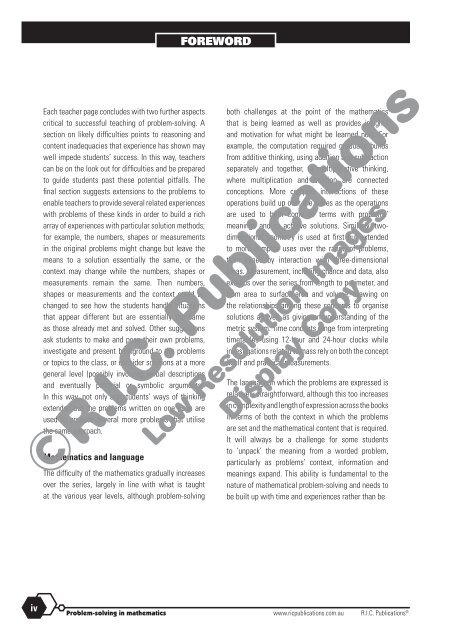20728_Problem_solving_Year_3_Background_information_resources
You also want an ePaper? Increase the reach of your titles
YUMPU automatically turns print PDFs into web optimized ePapers that Google loves.
FOREWORD<br />
Each teacher page concludes with two further aspects<br />
critical to successful teaching of problem-<strong>solving</strong>. A<br />
section on likely difficulties points to reasoning and<br />
content inadequacies that experience has shown may<br />
well impede students’ success. In this way, teachers<br />
can be on the look out for difficulties and be prepared<br />
to guide students past these potential pitfalls. The<br />
final section suggests extensions to the problems to<br />
enable teachers to provide several related experiences<br />
with problems of these kinds in order to build a rich<br />
array of experiences with particular solution methods;<br />
for example, the numbers, shapes or measurements<br />
in the original problems might change but leave the<br />
means to a solution essentially the same, or the<br />
context may change while the numbers, shapes or<br />
measurements remain the same. Then numbers,<br />
shapes or measurements and the context could be<br />
changed to see how the students handle situations<br />
that appear different but are essentially the same<br />
as those already met and solved. Other suggestions<br />
ask students to make and pose their own problems,<br />
investigate and present background to the problems<br />
or topics to the class, or consider solutions at a more<br />
general level (possibly involving verbal descriptions<br />
and eventually pictorial or symbolic arguments).<br />
In this way, not only are students’ ways of thinking<br />
extended but the problems written on one page are<br />
used to produce several more problems that utilise<br />
the same approach.<br />
Mathematics and language<br />
The difficulty of the mathematics gradually increases<br />
over the series, largely in line with what is taught<br />
at the various year levels, although problem-<strong>solving</strong><br />
both challenges at the point of the mathematics<br />
that is being learned as well as provides insights<br />
and motivation for what might be learned next. For<br />
example, the computation required gradually builds<br />
from additive thinking, using addition and subtraction<br />
separately and together, to multiplicative thinking,<br />
where multiplication and division are connected<br />
conceptions. More complex interactions of these<br />
operations build up over the series as the operations<br />
are used to both come to terms with problems’<br />
meanings and to achieve solutions. Similarly, twodimensional<br />
geometry is used at first but extended<br />
to more complex uses over the range of problems,<br />
then joined by interaction with three-dimensional<br />
ideas. Measurement, including chance and data, also<br />
extends over the series from length to perimeter, and<br />
from area to surface area and volume, drawing on<br />
the relationships among these concepts to organise<br />
solutions as well as giving an understanding of the<br />
metric system. Time concepts range from interpreting<br />
timetables using 12-hour and 24-hour clocks while<br />
investigations related to mass rely on both the concept<br />
itself and practical measurements.<br />
The language in which the problems are expressed is<br />
relatively straightforward, although this too increases<br />
in complexity and length of expression across the books<br />
in terms of both the context in which the problems<br />
are set and the mathematical content that is required.<br />
It will always be a challenge for some students<br />
to ‘unpack’ the meaning from a worded problem,<br />
particularly as problems’ context, <strong>information</strong> and<br />
meanings expand. This ability is fundamental to the<br />
nature of mathematical problem-<strong>solving</strong> and needs to<br />
be built up with time and experiences rather than be<br />
iv<br />
<strong>Problem</strong>-<strong>solving</strong> in mathematics www.ricpublications.com.au R.I.C. Publications ®


















